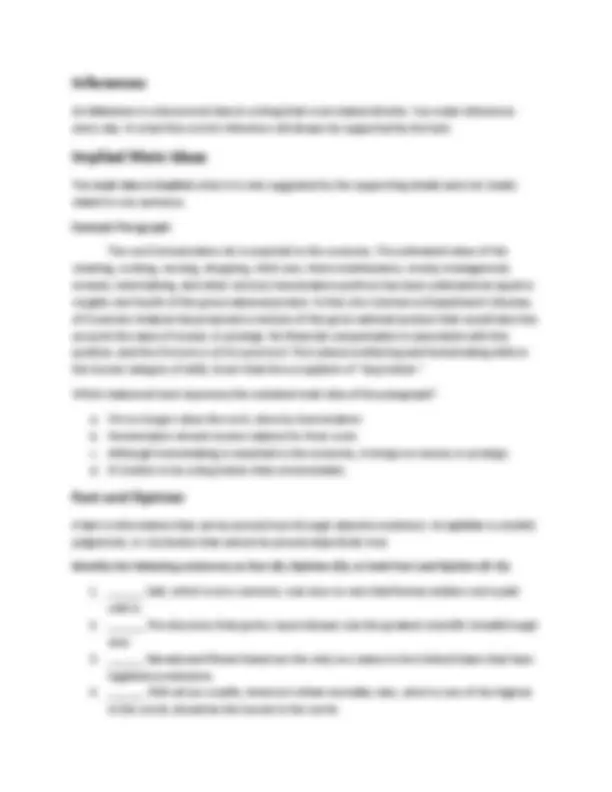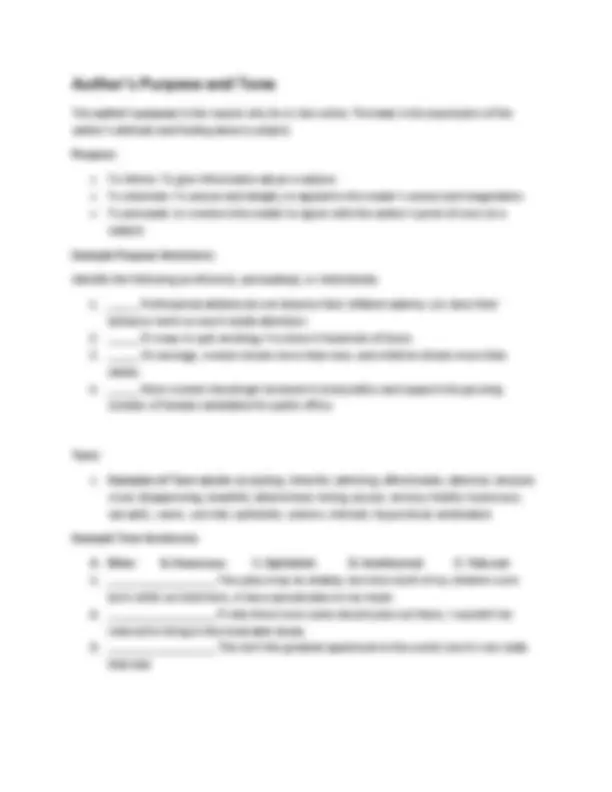





Study with the several resources on Docsity

Earn points by helping other students or get them with a premium plan


Prepare for your exams
Study with the several resources on Docsity

Earn points to download
Earn points by helping other students or get them with a premium plan
Community
Ask the community for help and clear up your study doubts
Discover the best universities in your country according to Docsity users
Free resources
Download our free guides on studying techniques, anxiety management strategies, and thesis advice from Docsity tutors
Examples of Main Ideas using List Words: o Emotional decisions can be divided into two main types. o Pathologists identify four different stages of cancer in ...
Typology: Exams
1 / 6

This page cannot be seen from the preview
Don't miss anything!




A main idea, main point or central point, is viewed as a general statement that is supported by other material in the paragraph.
List words:
Examples of Main Ideas using List Words:
o Emotional decisions can be divided into two main types. o Pathologists identify four different stages of cancer in the body. o Winners of presidential elections share various traits in common.
Supporting details are reasons, examples, facts, steps, or other kinds of evidence that explain the main idea. Major details explain and develop the main idea. Minor details help make the major details clear.
Addition Words:
One to begin with also further First (of all) for one thing in addition furthermore Second (of all) other next last (of all) Third (of all) another moreover final(ly)
Examples of Major Details Using Addition Words:
o One study shows that frequent TV watchers are more fearful and suspicious of others. o In addition , age is a biological factor to consider. o Muscle mass is another factor affecting our body temperature. o Finally, keeping pennies in circulation costs the nation as a whole.
Several kinds several causes of some factors in Three advantages five steps among the results Various reasons a number of effects a series of
Identify the following sentences as Main Idea (MI), Topic (T), Supporting Detail (SD):
Write the sentence number the corresponds with the Topic, Main Idea, Major Detail(s), and Minor Detail(s):
(^1) Functional illiteracy – the inability to read and write well enough to carry out everyday
activities – is a complex social problem that stems from several sources. 2 One source of the problem is our educational system. 3 Our schools are too quick to pass children from one grade to the next even when their learning is woefully deficient. 4 Even teachers who care may not want to “buck the system” by refusing to pass along students who have not yet learned important basic skills. 5 The community also contributes to functional illiteracy. 6 Local businesses and agencies, indifferent to education, do not work with schools towards improving children’s motivation and learning. 7 Another source is the home. 8 Millions of children grow up with illiterate parents who do not give them the opportunity or encouragement to learn language skills. 9 In all too many homes, a television is turned on much of the time, but there are few if any books to interest children in reading.
Pattern of Organization: _________________________________________________________
Main Idea: ____________________________________________________________________
Major Detail: ____________________________________________________________ Minor Detail(s): ____________________________________________________ Major Detail: ____________________________________________________________ Minor Detail(s): ____________________________________________________ Major Detail: ____________________________________________________________ Minor Detail(s): ____________________________________________________
An inference is a discovered idea in writing that is not stated directly. You make inferences every day. In a text the correct inference will always be supported by the text.
The main idea is implied when it is only suggested by the supporting details and not clearly stated in one sentence.
Example Paragraph:
The work homemakers do is essential to the economy. The estimated value of the cleaning, cooking, nursing, shopping, child care, home maintenance, money management, errands, entertaining, and other services homemakers perform has been estimated at equal to roughly one-fourth of the gross national product. In fact, the Commerce Department’s Bureau of Economic Analysis has proposed a revision of the gross national product that would take into account the value of money or prestige. No financial compensation is associated with this position, and the Dictionary of Occupational Titles places mothering and homemaking skills in the lowest category of skills, lower than the occupation of “dog trainer.”
Which statement best expresses the unstated main idea of the paragraph?
a. We no longer value the work, done by homemakers b. Homemakers should receive salaries for their work. c. Although homemaking is essential to the economy, it brings no money or prestige. d. It’s better to be a dog trainer than a homemaker.
A fact is information that can be proved true through objective evidence. An opinion is a belief, judgement, or conclusion that cannot be proved objectively true.
Identify the following sentences as Fact (F), Opinion (O), or both Fact and Opinion (F+O).
The author’s purpose is the reason why he or she writes. The tone is the expression of the author’s attitude and feeling about a subject.
Purpose:
o To inform: To give information about a subject. o To entertain: To amuse and delight; to appeal to the reader’s senses and imagination. o To persuade: to convince the reader to agree with the author’s point of view on a subject.
Example Purpose Sentences:
Identify the following as inform(i), persuade(p), or entertain(e).
Tone:
o Examples of Tone words: accepting, cheerful, admiring, affectionate, alarmed, amused, cruel, disapproving, doubtful, determined, loving, joyous, serious, fearful, humorous, sarcastic, warm, worried, optimistic, solemn, tolerant, hypocritical, ambivalent
Example Tone Sentences:
A. Bitter B. Humorous C. Optimistic D. Sentimental E. Tolerant
1. __________________ This place may be shabby, but since both of my children were born while we lived here, it has a special place in my heart. 2. __________________ If only there were some decent jobs out there, I wouldn’t be reduced to living in this miserable dump. 3. __________________ This isn’t the greatest apartment in the world, but it’s not really that bad.